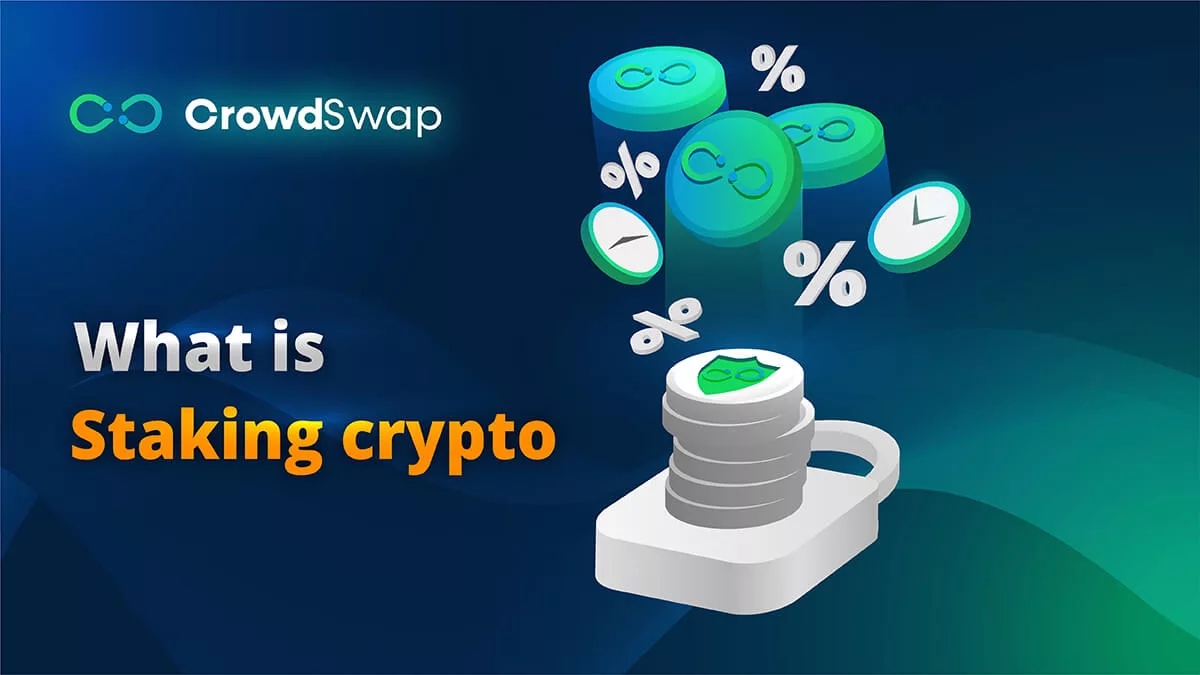What Is DeFi Staking?
DeFi, short for Decentralized Finance, is a relatively new term that has been making waves in the world of cryptocurrency. It refers to a system of financial applications built on top of blockchain technology, which allows for the decentralization of financial transactions and eliminates the need for intermediaries like banks. DeFi has been gaining popularity recently as it has the potential to radically change the way we think about traditional finance, from investment types to loans and paybacks. However, it can still be a vague concept for many people.
Before diving into DeFi staking, it’s important to understand what DeFi is and how it works. DeFi originated from the birth of the Bitcoin blockchain, which aimed to decentralize transactions and remove the need for intermediaries. In this post, we will provide you with a clear understanding of the nature and function of DeFi, followed by an explanation of how DeFi staking works, and many more. So, buckle up and get ready to explore the exciting world of DeFi!
What is Proof-of-Stake (PoS)?
Proof of Stake (PoS) is a consensus algorithm used in some blockchain networks as a way of validating transactions and creating new blocks. In contrast to Proof of Work (PoW), which is used by Bitcoin and some other cryptocurrencies, PoS relies on stakers (also known as validators) to validate transactions and create new blocks.
In a PoS system, stakers hold a certain amount of cryptocurrency as a stake in the network, which gives them the right to validate transactions and earn rewards. The amount of stake held by a staker is typically proportional to the amount of power they have in the network, meaning that the more stake a staker holds, the more power they have to validate transactions.
To ensure that stakers act in the best interest of the network, PoS systems often require them to put up collateral or bond. If a staker misbehaves, such as by double-spending or attempting to manipulate the network, they may lose their stake or face other penalties. PoS is generally considered to be a more energy-efficient and scalable alternative to PoW, although it also has its own set of challenges and limitations.
Why Don’t All Cryptocurrencies Have Staking?
Not all cryptocurrencies have staking because staking requires a PoS consensus mechanism. Therefore, cryptocurrencies that are based on the PoW consensus mechanism, like Bitcoin, cannot be staked. However, some PoW-based cryptocurrencies have implemented staking through second-layer solutions or through a hybrid consensus mechanism that combines PoW and PoS.
Additionally, even among cryptocurrencies that use PoS, staking may not always be possible or desirable, as it depends on the network’s design and the goals of the cryptocurrency’s developers.
For example, some cryptocurrencies may prioritize other use cases or features over staking or may not have a sufficient number of validators to support staking.
How Does Staking Crypto Work?
As aforementioned, one can be rewarded tokens as they lock their cryptos into a blockchain wallet. Staking crypto can be the decentralized version of the traditional deposit and earning profit system. The same as the traditional system, DeFi staking provides opportunities like borrowing, lending, and earning interest. That’s why it is a revolution in financial systems.
To see how DeFi staking functions, stakeholders need to acknowledge some conditions and tools, like the smart contract, platform, and liquidity pool. As mentioned before, transactions take place through a smart contract in which conditions of the contract, such as the period of locking crypto in a wallet and the leverage of profit-taking, are determined. Also, DeFi staking is available on platforms that provide a liquidity pool in which tokens are combined for stakeholders. The greater the pool, the lower risk of volatility.
Crypto Staking Risks
Like all other financial systems staking crypto might come across with some risks. However, compared to other crypto-based activities, the risks of staking crypto are so low. They can be considered the system with the lowest risk. The risks are:
• Earning relatively lower profit than expected in trading
• The value volatility of cryptos
• Inflation rate of cryptocurrencies
Advantages of Staking
Since intermediaries are eliminated through decentralization, and smart contracts are provided in platforms, from this point of view, DeFi staking has benefits for stakeholders like:
• Minimal need for attention compared to holding
• Low risk of crypto value decrease
• Safety and security of staked crypto via smart contract
• Lower risk rather than trading since no specialized skill is needed
• Almost no charging fees for transactions
Popular Crypto Staking Coins
The choice of the best staking coins can vary depending on individual preferences and investment strategies. Some investors prefer staking coins with higher staking rewards, while others focus on staking coins with strong development teams and promising future prospects. Popular staking coins often have unique features and capabilities that make them stand out from other cryptocurrencies. Examples of such coins include Ethereum (ETH), Cardano (ADA), Polkadot (DOT), and Solana (SOL). Ultimately, the choice of staking coins is a personal decision that depends on individual investment goals and strategies.
These coins have gained popularity due to their high market cap, strong development teams, and promising future prospects. Additionally, these coins have unique features that make them stand out from other cryptocurrencies, such as scalability, interoperability, and smart contract capabilities.
By staking these coins, users can earn rewards while also supporting the network’s operations and development, making them a popular choice for many crypto investors.
CrowdSwap is a DeFi project that offers a range of staking opportunities for both its native token, CROWD, as well as other popular cryptocurrencies. As a DeFi platform, CrowdSwap aims to provide a more accessible and decentralized way for users to manage their crypto assets, earn passive income, and participate in the governance of the network. One of the key features of CrowdSwap is its CROWD staking program, which allows users to stake their CROWD tokens and earn rewards in return.
Is Staking Crypto the Same as Liquidity Pool?
To answer this question, it is better first to review both terms. So, what is a liquidity pool? A liquidity pool is a store where tokens are reserved for decentralized crypto exchanges. However, staking crypto is a way of investing in the crypto world. To be more clarified, check out this example. Imagine you want to try out DeFi. One way is to stake, which now we all know about it. Staking tokens are available through liquidity pools. So, both terms are related but not the same.
What is APY in crypto staking?
APY, or Annual Percentage Yield, refers to the interest earned on an investment, typically compounded interest. Compounded interest is when the interest earned is added to the initial investment amount, and the next interest calculation is based on the new balance. In the context of cryptocurrency, APY is calculated for staking and yield farming activities on DeFi platforms. These platforms offer varying percentages of interest rates, which are compounded to increase the rewards.
The frequency at which interest is paid and added to the initial balance is the most crucial factor in APY calculation. The higher the frequency, the higher the APY. Interest is usually compounded quarterly, monthly, or daily, with interest added to the account becoming part of the average daily balance. Daily interest payment leads to a higher APY than a quarterly payment. The APY formula is calculated using the periodic rate of return, or annual APR, and the number of interest periods.
What is APR in crypto staking?
APR, or Annual Percentage Rate, is used to calculate the interest earned per year without compounding the interest. Unlike traditional loans or mortgages, where APR is used to determine the cost of borrowing money, in crypto, it refers to the amount of interest earned on staking and other DeFi activities. It is an essential metric for investors to evaluate the potential returns on their investments.
APR is typically different in each year of the loan, and it can vary based on factors such as market demand, volatility, and network fees. The actual amount of interest earned may be different from the APR if the rewards are compounded over time. Therefore, it is essential to understand the difference between APR vs. APY to make informed investment decisions. In summary, APR is a critical metric for calculating interest earnings on crypto investments, and understanding its implications is essential for making informed investment decisions.
DeFi Staking and Its Features
When it comes to earning money from the cryptocurrency world, staking is a popular one. Although staking crypto is about generating money, it is different from mining, while it is similar to holding on some levels. To understand the meaning of this term deeply, it can be a good idea to compare it with the holding way. To hold means to buy a coin and wait for the coin to increase its value. Staking crypto is committing the crypto assets to support a blockchain network and confirm transactions. It can take place with those cryptocurrencies which use the proof-of-stake algorithm to process payments. In this way, one can take the profit out of investing their money in specific cryptos and earn staking rewards.
It is a passive way of generating income. In staking crypto, you should buy those cryptocurrencies which use the proof-of-stake algorithm and then transfer and lock them into your blockchain wallet.
After investing specific tokens, you should join a liquidity pool, a tool in which stakeholders combine their tokens. They get rewards with tokens of the same block. The next step is the best one; earning the mentioned passive income. When stakeholders invest their money in a liquidity pool, they get rewards with tokens from the pool in their wallets. So, isn’t it a good idea to consider staking crypto easy money right in your pocket?
How Do I Start Staking?
To start staking in cryptocurrency, you will need to choose a cryptocurrency that supports staking and acquire it by purchasing, trading, or mining. There are many crypto swap platforms where you can swap your existing tokens to the ones you wish. After that, set up a wallet that supports staking, transfer the cryptocurrency to the wallet, and follow the staking instructions provided by the wallet to start staking and earning rewards. Keep in mind that staking usually requires locking up your cryptocurrency for a period of time, so it’s important to carefully consider your investment strategy and the risks involved.
If you’re new to staking in cryptocurrency, CrowdSwap offers an easy-to-use platform that simplifies the staking process. With just a few clicks, you can stake your cryptocurrency and start earning rewards. The app is designed to be user-friendly, with a step-by-step guide that takes you through the entire staking process. One of the advantages of using CrowdSwap for staking is its intuitive design, which makes it easy for anyone to get started. The app provides a dashboard where you can monitor your staking rewards, giving you greater transparency and control over your investment.
Start staking crypto with CrowdSwap now!
CrowdSwap’s DeFi Staking Platform
As noted above, to stake, you need a DeFi staking platform. Every cryptocurrency trader, whether advanced or not, is looking for an easy and handy way to earn passive income. The good news is that the solution is right away. CrowdSwap provides a user-friendly and good staking platform for stakeholders to stake their CROWD tokens in liquidity pools. You will receive 25% APY CROWD as interest. Then earned CROWD tokens and all the staked initially CROWDs will be transferred in the opposite direction, from the liquidity pool into their wallets. Stakeholders can invest and then sit back and watch. CrowdSwap will save you time and do the rest for you.
Trade Effortlessly
Ready to dive deeper? Our crypto exchange is simple and user-friendly, making trading a breeze
Conclusion
In conclusion, DeFi staking is a revolutionary concept that has emerged from the world of cryptocurrency. It allows investors to earn rewards by holding cryptocurrencies as a stake in a blockchain network and eliminates intermediaries like banks by decentralizing financial transactions. Proof-of-Stake (PoS) is the consensus algorithm used in some blockchain networks for validating transactions and creating new blocks. Staking is not available for all cryptocurrencies as it requires a PoS consensus mechanism.
However, staking is generally considered to be a more energy-efficient and scalable alternative to PoW. Crypto staking offers advantages like minimal need for attention, low risk of crypto value decrease, safety and security of staked crypto via smart contract, and lower risk compared to trading. Popular staking coins include Ethereum (ETH), Cardano (ADA), Polkadot (DOT), and Solana (SOL). DeFi staking is an exciting opportunity for investors looking to earn rewards while supporting the development and operations of blockchain networks.
FAQ
How do staking rewards work?
Staking rewards are typically distributed to participants who contribute to the network’s consensus mechanism by validating transactions and maintaining network security. The rewards can be in the form of newly minted cryptocurrency or transaction fees.
How can I start staking cryptocurrency?
To start staking cryptocurrency, you will need to choose a blockchain network that supports staking, purchase and hold the required amount of cryptocurrency, and choose a staking pool or validator to participate in the network’s consensus mechanism. Alternatively, you can visit CrowdSwap’s ‘OPPORTUNITIES’ page to see your options and start staking right away.
What is a validator?
A validator is an individual or entity that participates in the consensus mechanism of a blockchain network by validating transactions and maintaining the network’s security. Validators are typically required to hold a certain amount of cryptocurrency as collateral and are rewarded for their contributions to the network.
What is the difference between staking and mining?
Staking and mining both involve contributing to the validation and security of a blockchain network, but they differ in the method used. Staking involves holding and locking up a certain amount of cryptocurrency as collateral, while mining involves using computational power to solve complex mathematical equations to validate transactions.
Can I unstake my cryptocurrency?
Yes, it is possible to unstake cryptocurrency, but the process and requirements vary depending on the network and the specific staking arrangement. In some cases, there may be a waiting period or penalty for early unstaking.
What is a staking pool?
A staking pool is a group of cryptocurrency holders who pool their resources together to collectively stake their coins and increase their chances of earning rewards. Staking pools typically charge a fee for their services, but they offer the benefit of reducing the minimum staking requirement and providing a more consistent and reliable source of rewards.













